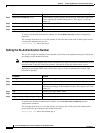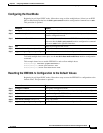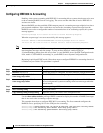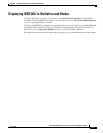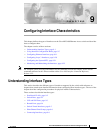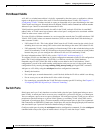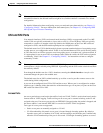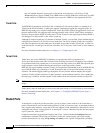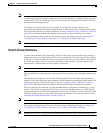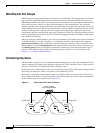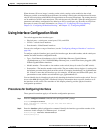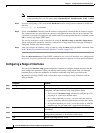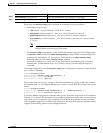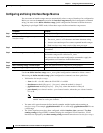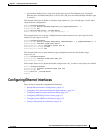
9-4
Cisco ME 3400 Ethernet Access Switch Software Configuration Guide
78-17058-01
Chapter 9 Configuring Interface Characteristics
Understanding Interface Types
they are enabled. Dynamic access ports on the switch are assigned to a VLAN by a VLAN
Membership Policy Server (VMPS). The VMPS can be a Catalyst 6500 series switch; the Cisco ME
switch cannot be a VMPS server. Dynamic access ports for VMPS are only supported on UNIs.
Trunk Ports
An IEEE 802.1Q trunk port carries the traffic of multiple VLANs and by default is a member of all
VLANs in the VLAN database. A trunk port supports simultaneous tagged and untagged traffic. An
IEEE 802.1Q trunk port is assigned a default Port VLAN ID (PVID), and all untagged traffic travels on
the port default PVID. All untagged traffic and tagged traffic with a NULL VLAN ID are assumed to
belong to the port default PVID. A packet with a VLAN ID equal to the outgoing port default PVID is
sent untagged. All other traffic is sent with a VLAN tag.
Although by default a trunk port is a member of multiple VLANs, you can limit VLAN membership by
configuring an allowed list of VLANs for each trunk port. The list of allowed VLANs does not affect
any other port but the associated trunk port. By default, all possible VLANs (VLAN ID 1 to 4094) are
in the allowed list. A trunk port can become a member of a VLAN only if the VLAN is in the enabled
state.
For more information about trunk ports, see Chapter 11, “Configuring VLANs.”
Tunnel Ports
Tunnel ports are used in IEEE 802.1Q tunneling to segregate the traffic of customers in a
service-provider network from other customers who are using the same VLAN number. You configure
an asymmetric link from a tunnel port on a service-provider edge switch to an IEEE 802.1Q trunk port
on the customer switch. Packets entering the tunnel port on the edge switch, already
IEEE 802.1Q-tagged with the customer VLANs, are encapsulated with another layer of an IEEE 802.1Q
tag (called the metro tag), containing a VLAN ID unique in the service-provider network, for each
customer. The double-tagged packets go through the service-provider network keeping the original
customer VLANs separate from those of other customers. At the outbound interface, also a tunnel port,
the metro tag is removed, and the original VLAN numbers from the customer network are retrieved.
Note IEEE 802.1Q tunneling is only supported when the switch is running the metro IP access or metro access
image.
Tunnel ports cannot be trunk ports or access ports and must belong to a VLAN unique to each customer.
For more information about tunnel ports, see Chapter 13, “Configuring IEEE 802.1Q and Layer 2
Protocol Tunneling.”
Routed Ports
A routed port is a physical port that acts like a port on a router; it does not have to be connected to a
router. A routed port is not associated with a particular VLAN, as is an access port. A routed port behaves
like a regular router interface, except that it does not support VLAN subinterfaces. Routed ports can be
configured with a Layer 3 routing protocol. A routed port is a Layer 3 interface only and does not support
Layer 2 protocols, such as STP.
Configure routed ports by putting the interface into Layer 3 mode with the no switchport interface
configuration command. Then assign an IP address to the port, enable routing, and assign routing
protocol characteristics by using the ip routing and router protocol global configuration commands.



